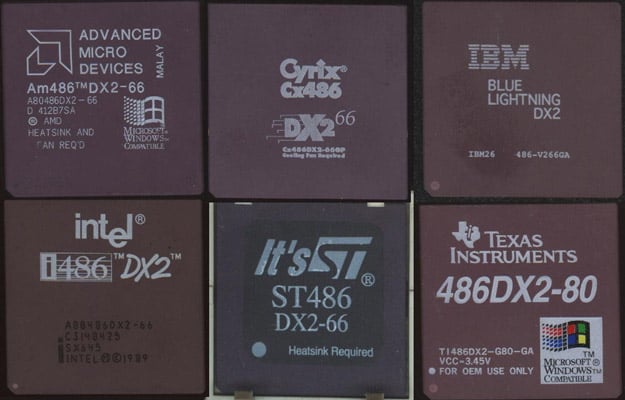Intel Fires Warning Shot At Qualcomm And Microsoft Over Windows 10 ARM Emulation In X86 Birthday Blog Post
"Today's consumers experience mobility in nearly every aspect of their lives and they've come to expect more from their PCs than legacy computing models are able to provide," said Cristiano Amon, executive vice president for Qualcomm Technologies late last month at Computex. "With compatibility for the Windows 10 ecosystem, the Snapdragon Mobile PC Platform will enable Windows 10 hardware makers to develop next-generation modern device form factors and deliver unparalleled anything, anywhere creation experiences with up to Gigabit Class LTE connectivity."

This powerful Qualcomm-Microsoft one-two punch is so potent that PC OEM heavyweights Lenovo, Hewlett-Packard and ASUS have signed on to deliver Windows 10 notebooks and 2-in-1 convertibles powered by Qualcomm's chips.
Until now, Intel sat by [relatively] quietly while all of this unfolded, but the company today took the opportunity to get a bit passive-aggressive while announcing the fast-approaching 40th anniversary of the world’s first x86 microprocessor, the 8086. The majority of the press release reads like a trip down memory lane, hitting highlights like MMX technology, SSE and SSE2 SIMD extensions and AES-NI encryption.

However, it quickly becomes clear that this isn’t just some high-tech birthday commemoration — Intel shifts into serious mama bear mode, with significant legal posturing, touting its willingness to protect its “x86 innovations” and use its legal might to stop any entity that might infringe upon its four-decade-old x86 ISA intellectual property.
“In the early days of our microprocessor business, Intel needed to enforce its patent rights against various companies including United Microelectronics Corporation, Advanced Micro Devices, Cyrix Corporation, Chips and Technologies, Via Technologies, and, most recently, Transmeta Corporation,” writes Intel’s Steven Rodgers and Richard A. Uhlig. “Enforcement actions have been unnecessary in recent years because other companies have respected Intel’s intellectual property rights.”
And this is where we circle back around to Qualcomm and Microsoft. Intel is clearly not happy about the potential competition that it will face from a new class of lightweight and power-efficient hardware that could adequately satisfy the needs of a large swath of PC customers, from notebooks to 2-in-1 hybrids and more. It's apparent that Intel feels its war chest of over 1,600 patents is likely being infringed upon with Microsoft and Qualcomm’s decision to make native support for ARM (with x86 compatibility) in Window 10 not only a possibility but a reality in retail-available products.
There have been reports that some companies may try to emulate Intel’s proprietary x86 ISA without Intel’s authorization. Emulation is not a new technology, and Transmeta was notably the last company to claim to have produced a compatible x86 processor using emulation (“code morphing”) techniques. Intel enforced patents relating to SIMD instruction set enhancements against Transmeta’s x86 implementation even though it used emulation.
Intel goes on to say that Transmeta tried and ultimately failed in the marketplace, and has been dead and buried for a decade. The company then pivots, almost daring Microsoft and Qualcomm to challenge it by making Windows on ARM devices commercially available:
Only time will tell if new attempts to emulate Intel’s x86 ISA will meet a different fate. Intel welcomes lawful competition, and we are confident that Intel’s microprocessors, which have been specifically optimized to implement Intel’s x86 ISA for almost four decades, will deliver amazing experiences, consistency across applications, and a full breadth of consumer offerings, full manageability and IT integration for the enterprise. However, we do not welcome unlawful infringement of our patents, and we fully expect other companies to continue to respect Intel’s intellectual property rights.
It is pretty easy to see why Intel feels threatened by not only Microsoft and Qualcomm, but also by some of its it biggest OEM partners — Lenovo, HP and ASUS — giving attention to a potential opportunity, outside of the Intel ecosystem, in the PC market. PCs running Snapdragon 835 processors will have much smaller circuit boards than x86-based machines, allowing OEMs to reclaim that space for larger batteries. All of the machines are claimed to come standard with integrated 1Gb LTE connectivity, and have up to 50 percent longer battery life than competing x86 machines, along with up to a 5x improvement in “connected standby” mode.
It is expected that Windows 10 PCs running Snapdragon 835 processors will arrive in the fall, just in time for the Windows 10 Fall Creators Update. However, Intel at this point seems poised to make sure that the launch meets serious opposition, one way or another. As an aside, the original Intel post was authored by Steven Rogers, EVP and General Counsel for Intel, as well as Richard Uhlig, Intel Labs Fellow and Director of Systems and Software Research.
Updated 6/9/2017 at 12:56pm
Qualcomm has provided the following official statement with regards to Intel's comments on x86 architecture:
Given our recent announcement with ASUS, HP and Lenovo, we found the blog that one of our competitors published on June 8 very interesting. We look forward to the launch of the always connected Windows 10 PC powered by the Qualcomm Snapdragon 835 Mobile PC Platform later this year. As showcased at Computex 2017 in conjunction with Microsoft, the Snapdragon 835 Mobile PC Platform brings a true always connected PC experience with support for up to Gigabit LTE connectivity and all-day battery life for sleek, thin and fanless designs. This will change the future of personal computing.
(Top Image Credit: Wikimedia Commons)



